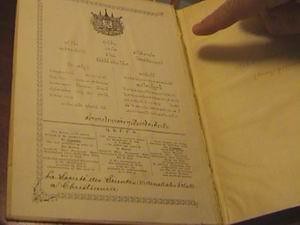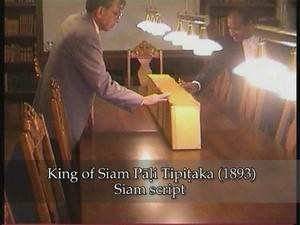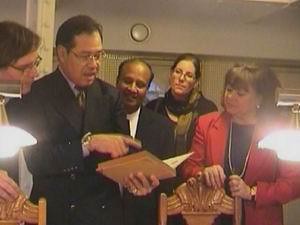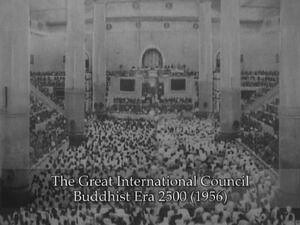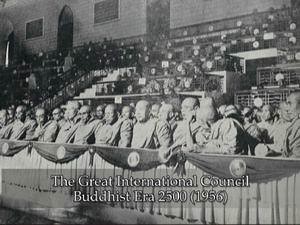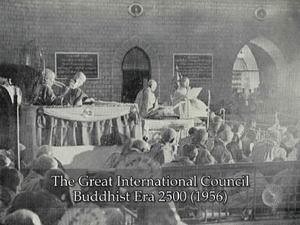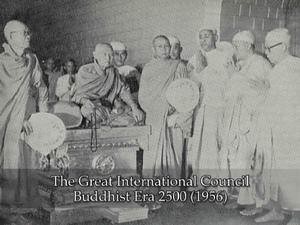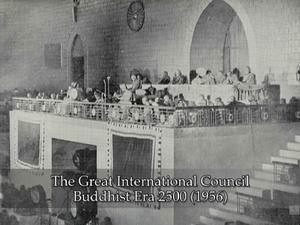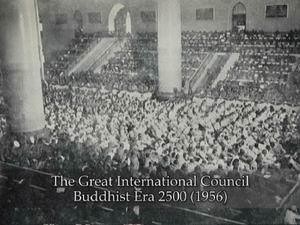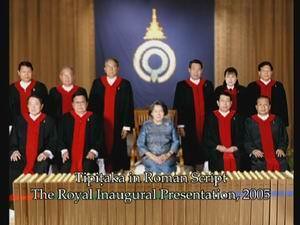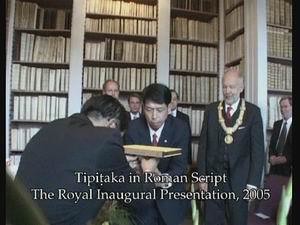Professor of History of Religions and Chair of Indic Religions
Lund University, Sweden.
Special visiting guest at Tipiṭaka Technology Exhibition
at Museum of Image Technology
Under the Patronage of
H.R.H. Princess Galyani Vadhana Krom Luang Naradhiwas Rajanagarindra
Organised by
Faculty of Science, Chulalongkorn University
and
Dhamma Society Fund
At the Museum of Image Technology
Under the Patronage of H.R.H. Princess Galyani Vadhana
Department of Imaging and Printing Technology, Faculty of Science,
Chulalongkorn University, Bangkok, Thailand
Monday 27 November 2006
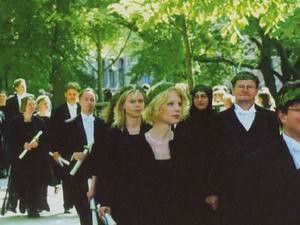
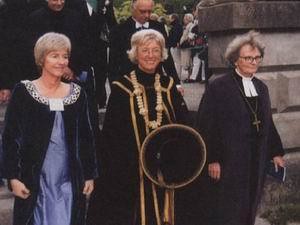

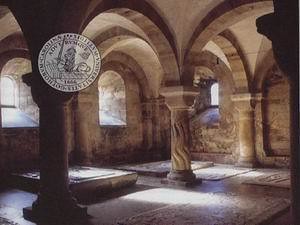
Today, as with most universities, the 35,000 students that are enrolled at Lund are affiliated with various faculties – including the faculty of Humanities and Theology; the centre for Theology and Religious Studies forms a part of that faculty and hosts the Department of History of Religions, which contains a special section on Indic religions.
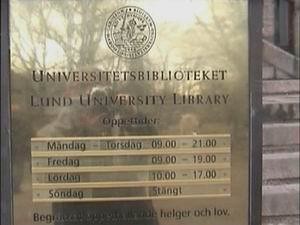
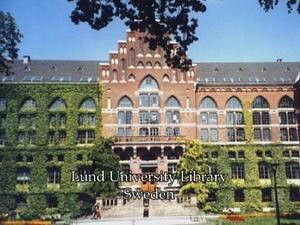
Although Sweden's formal study of Indic religions and languages is said to have originated in the 19th century, our library collections indicate that Buddhism was known to us as early as the 17th century, despite the fact that Sweden was neither a colonial power no involved in missionary activities in Asia.
Thus from the 17th to the mid 20th century, Swedish society was exposed to Buddhist ideology, first through the reports of Jesuit missionaries, travelers, etc., and later through the study of scholarly texts.
After the end of World War II, the Swedish population became exposed to traditional Buddhist practice through migrants that had arrived from traditionally Buddhist countries.

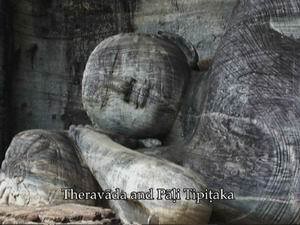

Studies in Buddhism
At around the same time, various forms of Buddhist meditation came to be practiced by indigenous Swedes – and by Europeans and North American as well.
Consequently, the study of Buddhism is not only indispensable in terms of obtaining a proper understanding of Asia's past and present; it is of significant relevance to our understanding of contemporary Western civilizations as well.
Long aware of Buddhism's impact on world cultural development, Lund University has been committed to the study of South and Southeast Asian thought form many years. Quite recently, however, our Center for Theology and Religious Studies has established a Chair devoted exclusively to the study of Indic religious, including Buddhism – the only one of its kind in Scandinavia. It is my great privilege to hold this Chair.
For the last several decades, Buddhist studies at Lund University have been largely focused on Mahayana forms such as Zen Buddhism, which has had a profound influence not only on popular Western culture, but on important Western disciplines such as psychology and psychotherapy as well; Tibetan Buddhism is another Mahayana form that has attracted great interest, partly due to the missionary activity and migration that occurred in the aftermath of the political situation in Tibet.
To counterbalance this trend, our Indic Religions Chair is committed to reintroducing the study of Theravāda Buddhism and Pāḷi (the language of the Tipiṭaka), building upon the heritage of such great scholars as Helmer Smith.
Smith had been an eminent master of the Pāḷi language whose many scholarly accomplishments included the editing of the “Saddanīti” – the most comprehensive of all Pāḷi grammars, authored in the 12th century by the Burmese scholar Aggavaṃsa.
in a rare book collection of Lund University Library
Lund University and Tipiṭaka Studies
Today I am happy to announce that our attempt to reintroduce Pāḷi and Tipiṭaka studies at Lund University may soon obtain a considerable boost.
In February 2004, we were honoured to receive a visit from Chancellor of the Dhamma Society Fund under the Patronage of the Supreme Patriarch of Thailand, together with a Pāḷi scholar from Peradeniya University, Sri Lanka.
The purpose of their visit had been twofold; first of all, they had been curious to learn whether or not the King of Siam Pāḷi Tipiṭaka, printed in 1893 by King Chulalongkorn Chulachomklao, remained in good condition and still located in our main university library; and secondly, they had come to announce the publication of a new, roman-script edition of the Theravāda Buddhist canon, “The Buddhist Era 2500 Great International Council Pāḷi Tipiṭaka” – a forty volume edition published by the Dhamma Society under the His Holiness Somdet Phra Ñāṇasaṃvara the Supreme Patronage of the Supreme Patriarch of Thailand.
Thus, in the midst of Sweden's dark and desolate winter, both scholars and students were warmed to hear about the valuable treasure that had been preserved right in our university library for over a century donated probably two years of printing in 1893 from Bangkok through the Royal Thai Embassy in London by King Chulalongkorn of Siam himself.
In 1897, in connection with his first European tour, King Chulalongkorn of Siam visited Sweden's King Oscar II in order to strengthen the ties between the two kingdoms; to memorialize that visit, a permanent Thai pavilion has recently been established in Utanede, Jamtland.
Moreover, in the century that has transpired since King Chulalongkorn of Siam made his generous donation, Buddhism has attained a rightful place in Swedish society.
The World Tipiṭaka Edition in Roman script, 2005
published in Bagnkok
in Yangon
The World Tipiṭaka Project
“The Buddhist Era 2500 Great International Council Pāḷi Tipiṭaka” published by the M.L. Maniratana Bunnag Dhamma Society fund, is the effort of 2,500 erudite monks from all Theravāda countries in Asia – including Thailand, Sri Lanka, Myanmar, Laos and Cambodia – participating in the Chaṭṭhasaṅgāyanā in Rangoon and celebrating 2,500 years of Buddhist teaching by reaching a consensus as to the reading of the Tipiṭaka, their common religious scripture.
This 1957 Tipiṭaka edition has been proof–read and romanised by the Dhamma Society's editorial and technical staff, which was comprised of scholars, monks, nuns from Thailand and Sri Lanka.
To preserve the Pāḷi Tipiṭaka and facilitate research and teaching, the most advance forms of modern IT and printing technology were employed in cooperation with Electrical and Computer Engineering Departments as well as the Imaging and Printing Technology Department, Chulalongkorn University.
And as the Dhamma society has chosen to emphasis the oral value of the Pāḷi language, this edition includes additional diacritics that facilitate recitation and pronunciation of the Pāḷi sound a system of which was first introduced in the printing of King of Siam Pāḷi Tipiṭaka.
Pāḷi language in Roman Script
The publication of this forty volume Pāḷi Tipiṭaka in Roman Script – along with its newly published twenty-volume companion – the Pāḷi Tipiṭaka Studies Reference 2006 – containing variant readings, indexes, cross–reference, etc., – is thus a monumental scholarly achievement.
On behalf of Lund University, I would like to extend my thanks to the M.L. Maniratana Bunnag Dhamma Society Fund for this priceless contribution to world culture and religion.
I would also like of extend a personal note of thanks to Maj. Bunnag, who, in memory of his dear mother, labored selflessly to bring this project to fruition.
The forthcoming Tipiṭaka to Lund University
It is my understanding that Lund University will be granted the opportunity of requesting a copy of this “Buddhist Era 2500 Great International Council Pāḷi Tipiṭaka” directly from Her Royal Highness Princess Galyani Vadhana, Tipiṭaka Patron and Honorary President of the Tipiṭaka Presentation Worldwide.
For this great privilege we are both delighted and thankful, and I must say that should our request meet with success, we intend to do more than merely add this new edition to our university library, although it is our humble honor to do so; through seminars, workshops, lectures and publications, we intend to promote the study of the Pāḷi Tipiṭaka throughout the scholarly world.
At Lund, the work has already begun: under our supervision, a research fellow of Sri Lanka's Peradeniya University will be writing a PhD thesis based up this Great International Council Pāḷi Tipiṭaka. And more is yet to come.
Tipiṭaka and the World : Beyond Academic Studies
Having said this, it must also be said that awarding this new romanised edition of the Pāḷi Tipiṭaka to Lund University will represent more than the mere granting of a gift to a school; beyond that, it will represent the granting of an invaluable treasure by the people of Thailand to the people of Sweden.
As such it will strengthen the bond between our countries established long ago by King Chulalongkorn Chulachomklao – countries that have known one another in times of joy as well as sorrow.
In recent times, the Tsunami catastrophe brought our nations together in tragedy, and all Swedes including our King have repeatedly expressed their deep gratitude for the tremendous kindness shown to Swedish victims by the Thai population.
The granting of the Pāḷi Tipiṭaka to Lund University thus has many dimensions – historical, intellectual, cultural and religious – and will open up new opportunities for cooperation between our two kingdoms.
The Three Inagural Editions
Presented to the President of Sri Lanka, the Constitutional Court of Thailand
and the Uppsala University Library, Sweden
In 2005, the inaugural sets of the World Tipiṭaka Edition was presented by H.R.H. Princess Galyani Vadhana as a donation to the Presidential Mansion of Sri Lanka, the Constitutional Court of the Kingdom of Thailand and to the University of Uppsala in Sweden – the Carolina Rediva. In 2006, the new standard edition was donated to the Parliament of Sri Lanka.
It is my humble wish that the forthcoming edition be donated to Lund University, one of Europe's most important centers of the international learning.
Thank you.

Dr. Olle Qvarnström
Professor of History of Religions and Chair of Indic Religions
Lund University, Sweden.

